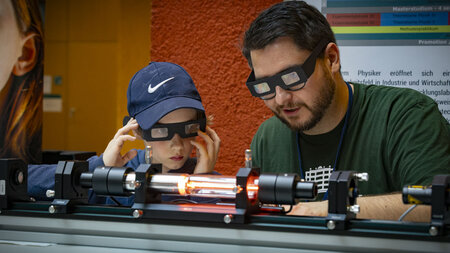Eintrag in der Universitätsbibliographie der TU Chemnitz
Volltext zugänglich unter
URN: urn:nbn:de:bsz:ch1-qucosa2-831105
Rayapati, Venkata Rao
Hiller, Karla (Prof. Dr.) ; Gemming, Sibylle (Prof. Dr.) (Gutachter)
Resistive switching in ferroelectric polycrystalline Yttrium Manganese Oxide thin films
Widerstandsschalten in ferroelektrischen polykristallinen Yttriummanganoxide-Dünnfilmen
Kurzfassung in deutsch
Ein Memristor ist ein Bauelement, welches eine Hysterese beim Vermessen seiner IU-Kennlinie aufweist. Dieses als „Widerstandsschalten“ bezeichnete Phänomen beruht auf der nichtflüchtigen Veränderung des Widerstandes. Es existiert eine breite Auswahl an Materialien, welche Widerstandsschalten zeigen, z.B. sind Phasenwechselmaterialien die Hauptkomponenten in aktuellen RRAMs. Aktuelle werden hauptsächlich Metalloxide untersucht, welche durch Migration von Anionen und Kationen Widerstandsschalten hervorrufen. Weitere Materialien wie hexagonale Manganoxidverbindungen RMnO3 (R = Y, In, Sc, Ho,...,Lu), besitzen zusätzliche multiferroische Eigenschaften, bei denen geladene Domänengrenzen weitere interessante Aspekte in dieser Materialklasse einführen und das Widerstandsschalten beeinflussen können.Die vorliegende Dissertation untersucht das Widerstandsschalten in Yttriummanganoxid-Dünnfilmen mit unterschiedlichen Kompositionen und unterschiedlichen Elektrodenmaterialien. Y1Mn1O3, Y0.95Mn1.05O3, Y1Mn0.99Ti0.01O3 und Y0.94Mn1.05Ti0.01O3, wurden mittels gepulster Laserdeposition auf metallisierte Si/SiO2 Substrate abgeschieden. Die elektrische Charakterisierung von Yttriummanganoxid-Dünnfilmen in einer Metall-Isolator-Metall Sandwichstruktur weist auf elektroformierungsfreies, unipolares Widerstandsschalten hin. Das beobachtete Widerstandsschalten wird auf die Formierung (niederohmiger Zustand) und Zerstörung (hochohmiger Zustand) des leitfähigen, metallischen Filaments (geladenen Domänengrenzen oder auch Vortices), verursacht durch thermisch-chemische Vorgänge, zurückgeführt. Die geladenen Domänengrenzen und/oder Vortices in Yttriummanganoxid-Dünnfilmen beeinflussen unter Umständen als nanoskalige Objekte die Formierung der leitfähigen Filamente. Die Stabilität der leitfähigen Filamente führt zu einer guten Langzeitspeicherung der programmierten Zustände, welche auch ein sehr großes Speicherfenster (Widerstandsverhältnis zwischen Aus/An-Zustand von 10^5) aufweisen. Die großen Widerstandsverhältnisse sind z.B. für die Herstellung von Auswahlschaltern (selektoren) in Crossbar-Strukturen notwendig, um die möglicherweise auftretenden Kriechströme in Crossbar-Strukturen zu unterdrücken, welche sonst Lesefehler der adressierten Zellen hervorrufen würden. Die Wiederbeschreibbarkeit ist in der Größenordnung von ca. 10^3, abhängig von der chemischen Zusammensetzung des Yttriummanganoxide-Dünnfilmes und vom verwendeten Elektrodenmaterial. Resultate der Charakterisierung mittels Rasterelektronenmikroskopie im Sekundärelektronenmodus mit einer kleinen Beschleunigungsspannung von 1.0 kV weisen auf geladene ferroelektrische Domänen in polykristallinem hexagonalen YMnO3 Dünnfilmen hin. Deswegen muß der Einfluss von geladenen Domänengrenzen und multiferroischen Vortices auf das beobachtete Widerstandsschalten in hexagonalem YMnO3 berücksichtigt werden.
Kurzfassung in englisch
A memristor is a two-terminal device which exhibits a hysteresis loop in the current-voltage characteristics. Resistive switching refers to reversible non-volatile change in state of the resistance. There exists a wide range of materials which show resistive switching i.e, phase change materials are used in today’s technology which are a main component of the resistive random access memory. In actual research, mostly metal oxides are investigated regarding their resistive switching which is based on migration of anions and cations. Additionally, in hexagonal manganites, h-RMnO3 (R = Y, In, Sc, Ho,...,Lu), the multiferroic properties and nano-sized conducting domain walls introduce further interesting aspects in this material class which may contribute to additional features in resistive switching.This dissertation investigates the resistive switching in yttrium manganite thin film (Y1Mn1O3, Y0.95Mn1.05O3, Y1Mn0.99Ti0.01O3 and Y0.94Mn1.05Ti0.01O3) based metal-insulator-metal structures with different top electrodes (Au or Al) and bottom electrodes (Pt or Pt/Ti or Pt/Cr) in 2-point DC probe measurements. Yttrium manganite thin films have been deposited by pulsed laser deposition on metal coated SiO2/Si substrates. Electrical characterization of yttrium manganite thin films in a metal-insulator-metal structure exhibit electroforming-free unipolar resistive switching. High voltages and currents are required for SET (V_𝑆𝐸𝑇 ) and RESET (I_𝑅𝐸𝑆𝐸𝑇 ), respectively. The observed resistive switching is assigned to the formation (low resistance state) and rupture (high resistance state) of conductive, metallic-like filaments induced by a thermo-chemical phenomena. Observed unipolar RS is classified as the thermo-chemical memory (TCM) resistive switching phenomena related to the locally increased temperature. The stability of conductive filaments leads to good retention of the programmed states with large memory window (OFF to ON resistance in the order of 10^4 - 10^6, depends on electrodes, electrode size and composition of yttrium manganite thin films). The endurance or number of loading cycles of the resistive switching devices are improved and is in the order of 10^3 for Y1Mn1O3 and Y0.95Mn1.05O3 composition with Al-top electrodes and Pt-bottom electrode. The maximum number of loading cycles is observed for an applied negative bias, a preferential negative polarity for switching the yttrium manganite thin film devices with Au or Al top electrodes and Pt or Pt/Ti bottom electrodes. Whereas, yttrium manganite thin film devices with Pt/Cr-bottom electrode and Al-top electrodes a preferential positive bias is required for switching the devices. Temperature-dependent measurements of yttrium manganite thin films deposited on Pt/SiO2/Si show semiconducting and metallic-like conduction in high resistance state and low resistance state, respectively. The activation energy (𝐸𝑎) extracted in the ohmic region for hopping of holes localized at Mn4+ is in the range of 0.36 eV - 0.43 eV.
Scanning electron microscopy in secondary electron emission mode with an in-lens detector and a small acceleration voltage of 1.0 kV is used to characterize the ferroelectric charged domain network formation in polycrystalline hexagonal yttrium manganite thin film. The observed bright regions correspond to local polarization vector with upward polarization components (+P𝑍 ) and dark regions to local polarization vector with downward polarization components (-P𝑍 ). A dense domain network is observed for Mn-rich samples (Y0.95Mn1.05O3 and Y0.94Mn1.05Ti0.01O3) in comparison to Y1Mn1O3 and Y1Mn0.99Ti0.01O3 with smaller grains show isolated charged domains. The observed dependency of different compositions to the charged domain density network in yttrium manganite thin films may influenced by different factors: stoichiometry gradient, oxygen, dopant concentration and the resulting grain structure.
| Universität: | Technische Universität Chemnitz | |
| Institut: | Zentrale Fakultätseinrichtungen ET/IT | |
| Fakultät: | Fakultät für Elektrotechnik und Informationstechnik | |
| Dokumentart: | Dissertation | |
| Betreuer: | Schmidt, Heidemarie (Prof. Dr.) ; Schulz, Stefan E. (Prof. Dr. Stefan E.) ; Bürger, Danilo (Dr.) | |
| URL/URN: | https://nbn-resolving.org/urn:nbn:de:bsz:ch1-qucosa2-831105 | |
| SWD-Schlagwörter: | Memristor , Resistives Schalten , Manganate | |
| Freie Schlagwörter (Englisch): | yttrium manganite thin films , memristor , resistive switching , unipolar resistive switching , ferroelectric , multiferroic , charged domains | |
| DDC-Sachgruppe: | Ingenieurwissenschaften | |
| Sprache: | englisch | |
| Tag der mündlichen Prüfung | 07.09.2022 | |
| OA-Lizenz | CC BY 4.0 |




